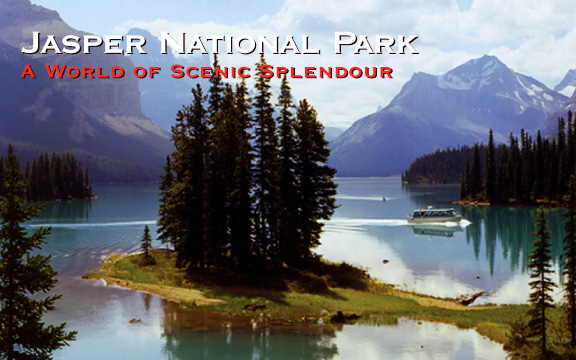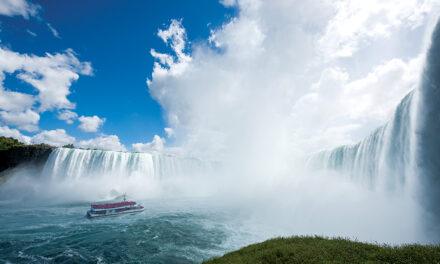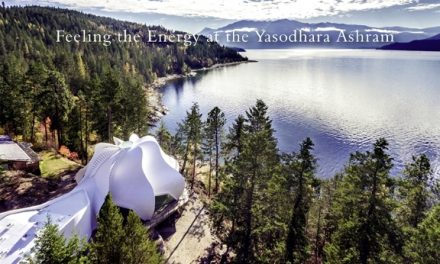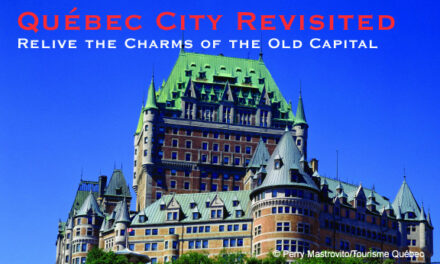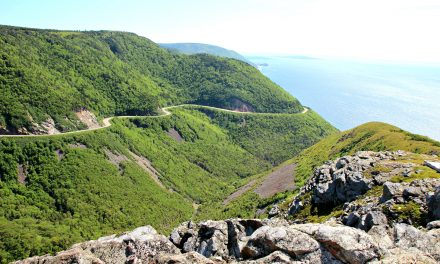Jasper National Park
A World of Scenic Splendour
Published in the Summer 2005 Issue of Canadian World Traveller
Text: By Habeeb Salloum (habeeb.salloum@sympatico.ca)
Photos: By Habeeb Salloum and courtesy of Jasper Tourism & Commerce (www.jaspercanadianrockies.com).
For two days we gloried in the fantastic world of Banff National Park, enjoying its many natural and man made attributes. We explored some of its castellated mountain peaks, dense forests, sweeping green meadows, turquoise lakes, sparkling rivers, roaring waterfalls as well as its dazzling white snowfields. Now, we were leaving this scenic panorama for the adjoining Jasper National Park – another majestic world of nature with very few equals in the world.
A short time after crossing into this wonder of nature, we reached the Columbia Icefields, formed by six glaciers – the largest accumulation of ice south of the Arctic Circle. Edged by 11 of the 22 highest mountain peaks in the Rockies and covering an area of 325 sq km (126 sq mi) and averaging 3,000 m (9,840 ft) in height, the six glaciers form a true ‘Continental Divide’ – their waters pouring, via the Athabasca and South Saskatchewan Rivers, into three different oceans: north to the Arctic; east to the Atlantic; and west to Pacific.
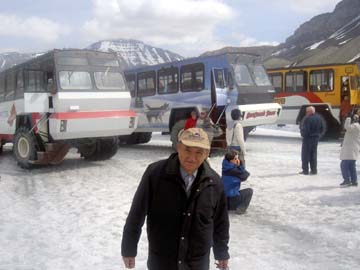 The Icefields
The Icefields
We stopped by the Icefields Centre – a huge chalet-like stone building built to serve annually a half a million visitors. Opened in 1996, the Centre houses exceptional interpretive exhibits and is located on a spot where one of the six glaciers, the Athabasca, is clearly visible. From its gigantic parking lot visitors can walk to the glacier’s edge and gaze at the enormous expanse of crevassed ice.
Like hundreds of thousands of other tourists, we took the Snocoach Tour onto the icy slopes of the huge glacier. After a short bus ride, we transferred to a 56 passenger Snocoach – a vehicle not found any place else on earth. Especially designed and built by a Calgary-based company for the Columbia Icefields, it took us to the middle of the Athabasca Glacier.
As we moved along, our young driver and guide explained the intricacies of the awe-inspiring glaciers. He was a real comedian peppering his talk with jokes. “Give me any question and I will give you an answer”, he clowned. When no one raised a question, he continued, “Mind you, I will likely not give the true answer.” Most of the passengers were still snickering, at the turn-around, below the glacier’s head wall, when our Snocoach stopped to give us a chance to walk atop centuries of accumulated snow, dotted with icy crevasses and ice-fed streamlets.
As we moved along, our guide pointed to the edging glaciers, “They’re majestic! Are they not?” He went on, “But if they continue receding at the present rate, in some 650 years they will disappear.”
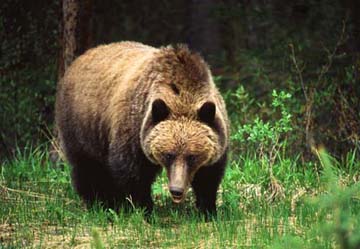 Jasper National Park
Jasper National Park
After returning from our 90 minute Icefields exploration, on the road again on our way to the town of Jasper, 103 km (64 mi) away, we entered a vast world of pine and spruce, emerald lakes, deep canyons, rugged sky-reaching snow-capped mountains, tumbling waterfalls, large wildlife-filled evergreen forests and the Athabasca River – one of the most historic and beautiful rivers in Canada. Driving through this landscape, I recalled the words of a traveller in this part of the province of Alberta, “The lure of the Wilds always called us onwards.”
Amid these endowments, tourists come in summer to enjoy the unspoiled hand of nature, in autumn to glory in a landscape of amber and gold, in winter to ski and in spring to admire the valleys of flowers breaking through patches of snow. Annually, these attributes draw 3 million visitors from the four corners of the world.
Established in 1907 on the eastern slopes of the Rockies, Jasper National Park is Canada’s largest Rocky Mountain Park covering an area of some 10,878 sq km (4,200 sq mi)) with 1,200 km (745 mi) of wilderness trails. A part of the Canadian Rocky Mountain World Heritage site, the Park is a fine example of enjoying outdoor recreation in a protected mountain ecosystem. Due to its outdoor splendour and unspoiled grandeur, some have labelled it ‘Paradise on Earth’.
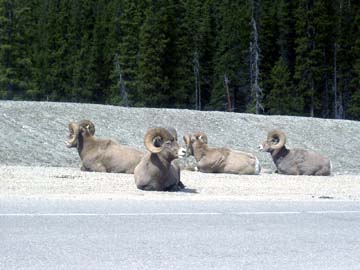 The Icefield Parkway
The Icefield Parkway
Often called the most scenic highway in the world, the Icefield Parkway is made up of fantastic scenery as well as numerous picnic areas and campgrounds along with easy access to hiking trails. Drivers ensnared with nature and thinking of stopping at some rest area need beware that at any time a deer or another wild animal might amble onto the road.
Making our way northward on the Icefield Parkway, considered to be the most scenic route on earth, we stopped numerous times to take pictures of wild animals by the roadside or on the mountainsides. The montane zone below the sub-Alpine Zone through which the railway passed was a friendly mountain level for both beast and man. At other times we moved to the side of the highway to admire some eye-catching scenic site or just admire the breathtaking hand of nature.
We stopped awhile at Sunwapta Falls watching with other travellers the Sunwapta River tumbling into a limestone gorge. Moving forward to have a good look at the Falls I heard a woman tell her daughter, ” See how wondrous is nature! The plummeting waters! The white tipped mountains and the tree-covered mountainsides. Isn’t it enchanting!”
The Athabasca Falls
Continuing on our picturesque drive, we turned a short distance off the main road to admire the Athabasca Falls, a spot where the Athabasca River is funnelled into a narrow canyon. Some 38 km (23 mi) further on and we were in the town of Jasper, the Park’s main town of some 4,500. Nestled in the bosom of the Rockies amidst an unspoiled part of nature, its well-kept buildings, cuddled by towering mountains, has made it an idyllic vacation mecca. Its first class tourist facilities, makes it easy for visitors to be comfortable and at the same time enjoy the many natural attributes of the Park. Here, whatever the season, travellers can partake in mountain adventure and make contacts with the animals of the wild.
The next day, from this neat, cosy resort, in less than 20 minutes we were in the eye-bulging Maligne Canyon, formed by the swirling and churning waters, which have worn the limestone rocks in places 55 m (165 ft) deep. Located 11.7 km (7 mi) from the town of Jasper, it is one of the most spectacular gorges in the Canadian Rockies, incorporating an extensive above and underground river system.
Standing on one of the Canyon’s six bridges, while being soaked with the spray of the thundering Maligne River, an American woman beside me, one of the thousands of US citizens that annually pour into the park, remarked, “It’s like we’re children again. Only this time it’s the majestic hand of nature, not a hose watering the grass.”
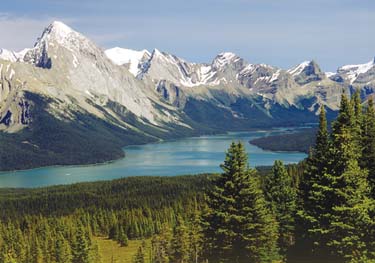 The Medicine Lake
The Medicine Lake
Past the 6.3 km (4 mi) long Medicine Lake, which has no surface outlet, and disappears in autumn and winter through underground channels, we came to Maligne Lake – 48 km (29.8 mi) from Jasper. Stretching for 22 km (14 mi), it is the second largest glacier-fed lake in the world. Set in the imposing Maligne Valley, the lake, the largest in Jasper National Park, is surrounded by glacier-studded mountain peaks. Atop its waters we enjoyed a 90-minute boat ride, before returning to Jasper for the night.
That evening, I reminisced about our two-day exploration of Jasper National Park with its Icefield. It had been a fulfilling experience. The sky-reaching mountains, colourful and icy rivers, thundering waterfalls, endless forests of fir and spruce, and, above all its prehistoric Icefields made it a once in a lifetime journey.
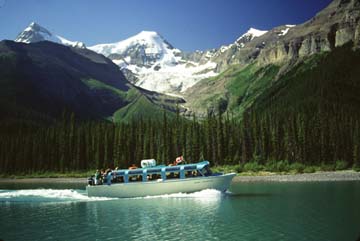
How to Get There
Jasper is situated about the same distance from Calgary and Edmonton, Alberta’s capital – about a five-hour drive. Both have excellent air, road and rail connections. Also, there are good rail and bus connections with Jasper. However, the ideal way to travel to the resort is to rent an auto and explore the park. The roads inside the park are excellent and the viewpoint sites are endless. In addition, there are excursions offered from both Calgary and Edmonton.
Other Important Sites
Jasper Tramway, the longest aerial tramway in Canada, features a 7-minute, 2,500 m (8,205 ft.) trip to the top of Whistler’s Mountain.
Miette Hot Springs, about 60 km (37 mi) east of Jasper. At 53º C, they are the hottest mineral springs in the Rockies. However, their waters are cooled to 40º and chlorinated for bathers.
Pyramid and Pyramid Lakes, just 8 km (5 mi) from the heart of town, is well worth the trip just to view the beauty of the two lakes in the shadow of the towering Pyramid Mountain.
Two Top Places to Stay
The Fairmont Jasper Park Lodge – the hotel, spreading along the curve of Lac Beauvert, a short distance from town, incorporates a golf course and combines the ultimate in luxury with tranquility and natural beauty. A village unto itself, it consists of lavish log cabins and cedar chalets.
E-mail: jasperparklodge@fairmont.com. Website: www.fairmont.com/Jasper.
Marmot Lodge – the rooms look out upon the beauty of the mountains rising above the park-like grounds and the forests beyond. Email: marmotlodge@mpljasper.com. Website: www.marmotlodge.com.
Some Interesting Tours
Jasper Adventure Centre offers these tours: Maligne Valley, Canyon and Lake Tour – cost $50., Miette Hot Springs and Watchable Wildlife Tour – cost $54., and The Columbia Icefields Tour from Jasper – cost $107.
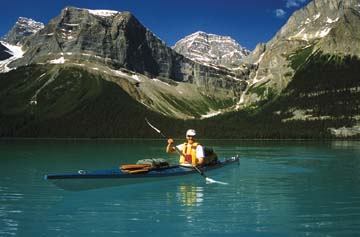 For More Info:
For More Info:
Jasper Tourism & Commerce
P.O. Box 98, Jasper, Alberta TOE 1EO.
Tel: (780) 852-3858 Fax: (780) 852-4932
E-mail: jaspercc@incentre.net
Website: www.jaspercanadianrockies.com
Travel Alberta
P.O. Box 2500, Edmonton, AB T5J 2Z4
Tel.: 780-427-4321 or 1-800-252-3782
Fax: 780-427-0867
Email: travelinfo@travelalberta.com
Website:www1.travelalberta.com/canada

